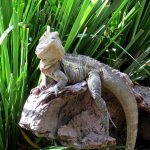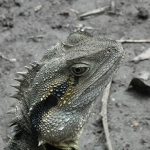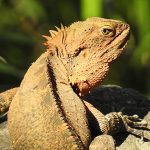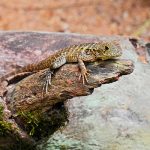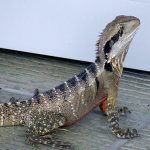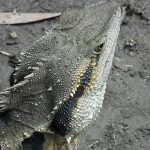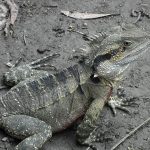EASTERN WATER DRAGON
Eastern Water Dragon
The Eastern Water Dragon is one of Australia’s most iconic and charismatic lizards. Found along the eastern seaboard, this semi-aquatic reptile is often seen basking on riverbanks, darting up trees, or splashing into the water at the slightest sign of disturbance. With its striking appearance, fascinating behaviours, and adaptability to both wild and urban environments, the Eastern Water Dragon has become a beloved symbol of Australia’s waterways.
Appearance
The Eastern Water Dragon is a large, robust lizard, growing up to 1 metre in length, with over two-thirds of that length being its long, muscular tail. Its body is covered in rough, overlapping scales that provide both protection and camouflage.
- Colouration: Generally grey to olive-brown with darker bands across the back and tail. Males often display bright red bellies and throats, especially during the breeding season, while females and juveniles tend to be paler.
- Distinctive Features:
- A prominent crest of spines running along the head, neck, and back.
- Long, strong limbs with sharp claws for climbing.
- A laterally flattened tail, perfectly adapted for swimming.
Distribution and Habitat
This subspecies, Intellagama lesueurii lesueurii, is widespread along the eastern coast of Australia from Cooktown in Queensland down through New South Wales and into eastern Victoria.
- They are strongly associated with freshwater environments such as rivers, creeks, lakes, and even suburban ponds.
- In cities like Sydney and Brisbane, they thrive in botanic gardens, parks, and golf courses, often coexisting with people.
Behaviour and Ecology
Eastern Water Dragons are diurnal (active during the day) and exhibit a remarkable mix of behaviours that help them survive in different environments.
- Basking: They are often seen soaking up the sun on rocks, logs, or pathways, relying on external heat to regulate their body temperature.
- Swimming: Highly skilled swimmers, they use their long tails like rudders. If threatened, they will dive into the water and can remain submerged for up to 90 minutes.
- Climbing: Agile climbers, they often run up tree trunks to escape predators.
Diet
They are omnivorous, meaning they eat both animal and plant matter. Their diet includes:
- Insects (ants, grasshoppers, beetles)
- Small vertebrates (frogs, small fish, even hatchling birds)
- Fruits, flowers, and leaves
Breeding
Breeding season occurs in spring and summer. During this time:
- Males become territorial, displaying their bright red chests and performing head-bobs and arm-waves to assert dominance.
- Females lay between 6 to 18 eggs in a burrow dug into soft soil, usually near a water source.
- The eggs are left to incubate in the warmth of the soil, hatching after about three months.
Conservation and Human Connection
The Eastern Water Dragon is not threatened and has adapted well to urban environments. In fact, many Australians encounter them in city parks, where they have become a familiar and much-loved presence.
However, they still face threats from:
- Habitat destruction through land clearing and waterway pollution
- Predation by cats, dogs, and foxes
- Road accidents in urban areas
By protecting waterways, planting native vegetation, and keeping pets under control, humans can help ensure these dragons continue to thrive.
Imagine walking along a shaded creek in eastern Australia. The air smells of damp eucalyptus leaves, and the sound of water trickling over stones fills the background. Suddenly, a rustle in the leaf litter reveals a sleek, spiny-backed lizard. Its scales glisten in the sunlight, eyes alert and unblinking. In a flash, it dives into the water, leaving only ripples behind—a perfect reminder of the wild heart that beats in Australia’s landscapes.
Quick Facts
| Feature | Detail |
|---|---|
| Scientific Name | Intellagama lesueurii lesueurii |
| Common Name | Eastern Water Dragon |
| Size | Up to 1 metre long |
| Lifespan | Around 15 years in the wild |
| Distribution | Eastern Australia (Qld, NSW, Vic) |
| Habitat | Rivers, creeks, lakes, urban waterways |
| Diet | Omnivorous (insects, small animals, plants) |
| Conservation Status | Least Concern |


